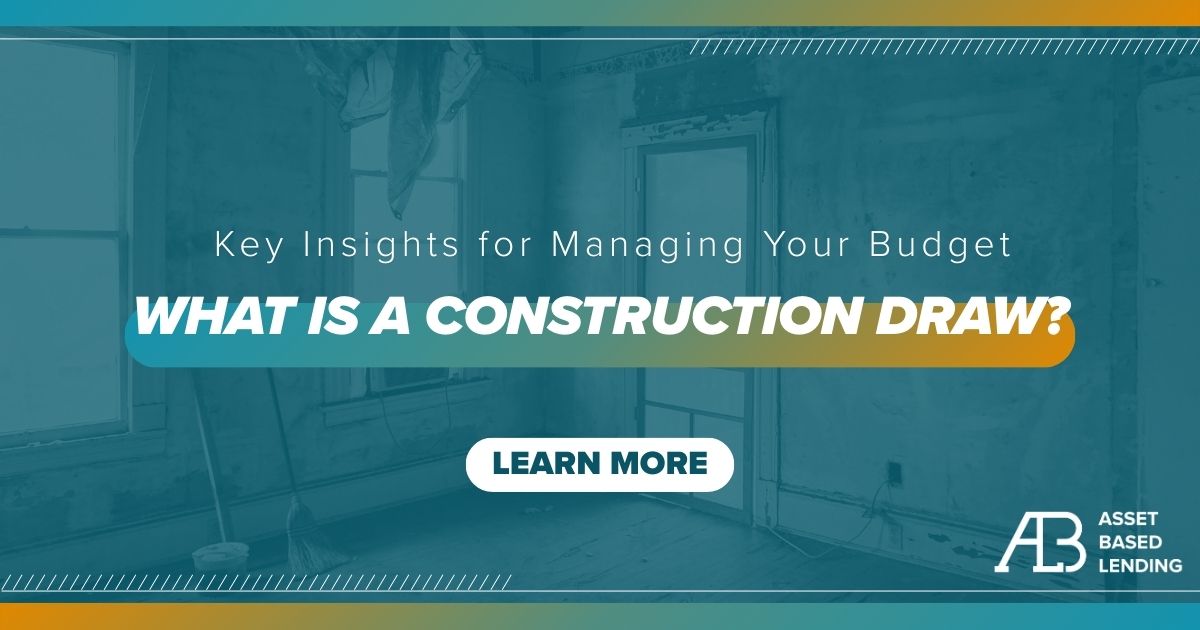Managing cash flow is an important part of any construction project. It’s how you keep a project moving with the appropriate funding. To ensure your next real estate investment runs smoothly, learn what a construction draw is and how it works.
At ABL, we’ve funded countless new construction and fix-and-flip projects nationwide with our fast, flexible loan programs. We can help you stay on budget and schedule with our fast inspections and quick fund disbursements.
What Is a Construction Draw?
A construction draw is a scheduled fund disbursement from a construction loan to cover building costs like labor and materials. It’s part of a larger construction draw schedule you and your lender agree on before closing the loan.
What Is a Construction Draw Schedule?
When you get a fix-and-flip or new construction loan, the loan funds aren’t disbursed all at once. Instead, they’re spread out over the construction project. This not only minimizes the lender’s risk (of you not finishing the project and repaying the loan) but lowers your interest costs.
After all, most construction loans, including those from ABL, only require you to make interest payments during the loan term. By staggering the loan disbursement, you essentially limit the loan balance on which interest is calculated.
However, construction draw schedules aren’t arbitrary. They must align with the budget and actual cost of the project. This is why the timing and size of construction draws are often tied to agreed-upon project milestones, such as the completion of the foundation, framing, utilities, etc.
Each time you hit a construction milestone, the lender sends out an inspector to verify that the work has been completed. Then, they disburse the next draw to keep the project moving.
Construction Draw Schedule Template
Curious about what a construction draw schedule looks like? Take a look at ABL’s construction draw schedule template in our Document library. You can download it for free as a starting point for your own construction draw schedule.
Disclaimer: ABL does not provide investment advice or guarantee that its draw schedule template is suitable for any particular project. The template is meant to be an example only.
The Construction Draw Process
Now that you know what construction draws are, here’s how they get processed:
1. Construction Draw Request
Once you meet a construction milestone, request a draw from your lender. Your draw request must typically include the following:
- A draw request form: This is a lender-issued document that you fill with the requested draw amount and a description of the work completed.
- Invoices and receipts: These are included as proof of payment to contractors, suppliers, and subcontractors.
- An updated schedule of values: This is an updated breakdown of project costs so far to show how funds are being allocated and what’s left to complete.
- Any change orders: These are submitted if the schedule of values needs to be adjusted due to unexpected project costs.
- Lien waivers: These are signed statements from contractors and suppliers confirming they’ve been paid and waiving future claims against the property.
2. Document Review
Once the draw request is submitted, the lender reviews all the documents to ensure they are complete and accurate. They check that invoices, receipts, and lien waivers match the requested amount and that any change orders are properly accounted for. If there are discrepancies, the lender may request additional documentation before moving forward.
3. Inspection and Verification
Next, the lender sends an inspector to the construction site to verify that the completed work aligns with the draw request and that the project is progressing according to plan.
4. Lender Approval and Fund Disbursement
If everything checks out, the lender approves the draw amount and transfers the requested funds directly to your bank account. At ABL, we typically wire money within 3-4 days of your initial draw request.
Note: Some lenders hold back a portion of each draw amount (typically 5-10%) until the project is complete. This is called “retainage” and helps ensure contractors finish their work properly.
Construction Draw Best Practices
To ensure a smooth construction draw process, follow these best practices:
Base the Draw Schedule on Clear Milestones
Instead of basing the draw schedule on completion percentages (e.g., 20%, 40%, 60%, etc.), attach specific construction milestones to each draw (e.g., foundation complete, framing complete, etc.). This avoids disputes and potential payment delays.
Create a Conservative Budget
When you create a draw schedule, ensure you are basing construction costs on historical data and actual quotes from contractors. Give yourself some cushion in case costs run over (common in construction).
Carefully Monitor Construction Progress
Keep a close eye on construction costs and timing. If you anticipate delays or cost overruns, try to make adjustments in other areas to stay on schedule and on budget. Otherwise, be proactive in submitting change orders and updating the schedule of values.
Keep Accurate Records
Hold onto any invoices, receipts, and other relevant construction documents so that when it comes time to request a draw, you won’t lose any time looking for them. Keeping good records can also protect you against potential disputes with contractors and other stakeholders.
Regularly Communicate with Your Lender
Keep your lender updated on construction progress. This helps ensure a smooth draw process and prevents misaligned expectations. At ABL, we’re more than just a lender. We’re here to provide our expert support every step of the way—from the initial draw to the project completion.
Common Construction Draw Challenges
Finally, here are some common construction draw challenges to avoid:
Cost Overruns
Fluctuating material prices, labor shortages, and inclement weather can lead to cost overruns that can strain or delay construction draws. However, you can avoid this by creating a realistic budget and maintaining cash reserves.
Construction Delays
Permitting issues, contractor scheduling, and bad weather can slow down a construction project, delaying draw requests. However, if you carefully monitor construction progress and plan in extra time, you can minimize delays.
Change Orders
Modifying the project scope can affect the construction budget and timeline, requiring adjustments to the draw schedule. That said, ABL can work with you even if things don’t go exactly according to plan because, ultimately, we want you and your project to succeed.
Ready to take the next step on your real estate investing journey? Pre-qualify for a construction loan today! We’ll let you know within 24 hours if your project may be a good fit.







0 Comments